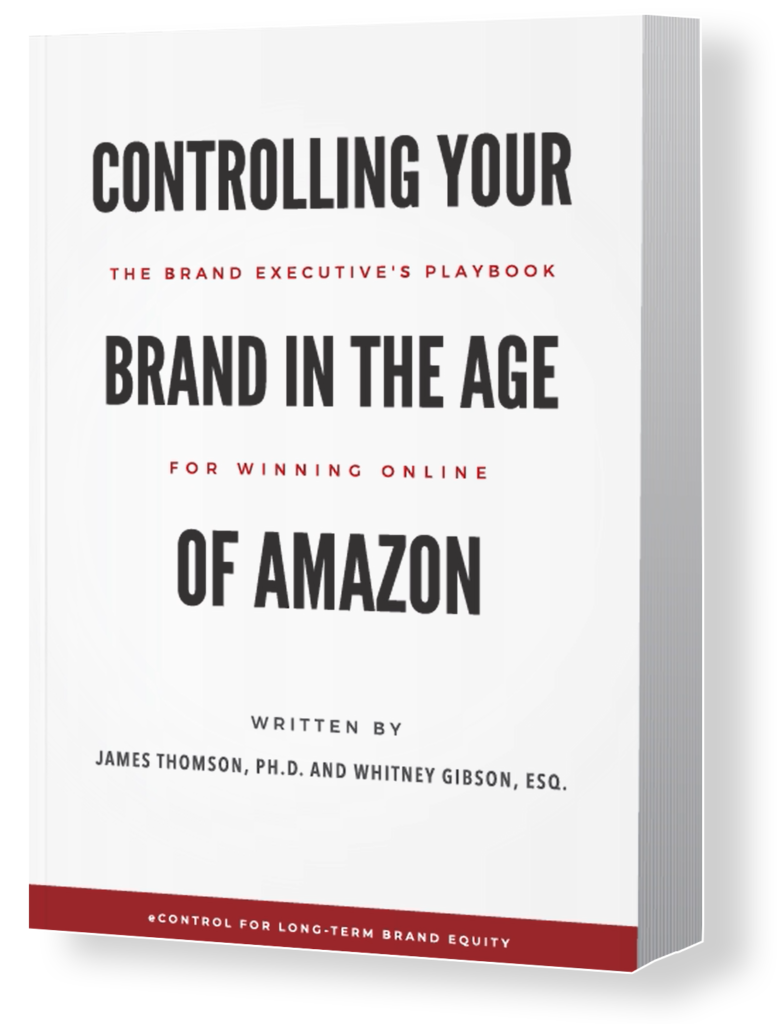At the end of January 2020, I had the opportunity to speak with James Thomson and Whitney Gibson, the authors of a new book Controlling your brand in the Age of Amazon. As Amazon’s dependence on third-party sellers has grown from 3% in 1999 to 58% of Amazon’s retail operation, it becomes critical for brands to control the Amazon channel properly.
Thomson, the first Fulfillment by Amazon (FBA) account manager and Gibson share actionable strategies for brands to use to gain or regain control over Amazon sales. It is worth noting that the authors deal with brands on a daily basis. Marketplace channel management in their full-time occupations, Thomson on the consulting side as a partner at Buy Box Experts and Gibson as a Partner at Vorys, Sater, Seymour and Pease LLP. This enables e-commerce executives to leverage expertise gained from helping brands use Amazon as a profitable channel for e-commerce sales.
What worked in Retail needs a mind shift for Amazon
However, brands have utilized retail distribution through wholesalers, distributors in an unorganized manner in the name of sales generation. In the past, this behavior would not lead to negative consequences due to geographical differences between cities. As marketplaces have become the starting point for consumers in their path to purchase, they have been able to access selection by leveraging this wild and unorganized distribution. Even if brands have not been interested in selling on marketplaces, the marketplaces have been able to locate products. They have multiple sellers selling the same product, which is great for consumers but potentially unprofitable for brands.
As marketplaces such as Amazon stive to provide consumers with the lowest pricing for an item, if a distributor has a lower price than the marketplace, the marketplace would then adjust their pricing. Channel conflict will create unhappy partners who feel hard done by as one of their competitors has a lower price and thus generating sales, but the brand would be fitting the bill for margin and price chargebacks from retailers. The pricing transparency found on Amazon impacts distributors and retailers, and vice versa is visible to consumers.
This price erosion and channel conflict are leading progressive brands to look for strategies to distribute their products in a more controlled manner. Very importantly, due to the size of marketplaces, counterfeit products are also a separate issue from the divergence of authorized products to unauthorized channels. As marketplaces can be compared to extensive freeways with large amounts of traffic, the brands are not following the road as someone else is driving the car and determining the direction of brands. Counterfeits and unauthorized sales are primarily the symptoms of brands not being control of their assets on marketplaces. This behavior for brand management is called eControl, in which brands are retaking control of their distribution as whack-a-mole management is unsustainable.
While eControl is complicated, it requires new thinking from the industry as an outdated methodology is being used (is this a content issue, trademark issue, do I speak with my lawyer, a monitoring company?) to solve the problems that emerge. The strategies utilized must be legally compliant, leverage expertise from the law sector, and brand consulting to develop a roadmap that is an end-to-end solution for brands. This end-to-end approach maps a new world (marketplaces) and removes confusion in how to address this industry and its challenges. Brands still think that they can initiate a conversation when adding a new channel to their marketing mix; Amazon offers complexity such as first-party and third-party sales. The Amazon strategy required a co-ordinated executive approach to account for a single large channel that distributes products to consumers with little effect from brands.
This new channel requires a mind shift related to content, policies (who can sell were), the aggressiveness of policy enforcement, and the alignment or misalignment of incentives through marketing. It requires the utilization of levers from business and legal as using one element can impact growth and control, but if executed, it can lead to prolonged profitability.
What challenges do unauthorized sales on Amazon provide brands?
Your channel partners selling on channels they are not supposed to, third-party sellers who utilize leaks in distribution. These do not have to follow a pricing policy on Amazon, which creates drama with retailers who are seeing a brand unable to control its distribution and only focus on specific partners in terms of pricing. This erosion of pricing is one of the first things brands notices as it leads to a race to the bottom for pricing and profitability, which will be matched by Amazon or other sellers. The parties are likely to sell inferior quality products as they are not vested in the brand’s quality control process, which leads to negative reviews for the brands, which hurt the brand. Brands lose organic SEO traffic based on the bad reviews on Amazon. Retailers are increasingly unwilling to offer shelf space to brands that have uncontrolled distribution, and thus, brands lose a selling opportunity. Brick and mortar businesses are at risk for brands when marketplace channel control does not exist.
They may also create brand content on Amazon, which leads to inconsistent messaging as branding is a set of promises a brand makes to consumers. The inconsistent content leads to brand confusion for consumers as messaging is different on channels. If the messaging is not tightly controlled for a first-time brand-consumer on Amazon, consumers potentially will not purchase or interact with a brand a second time on Amazon or another channel. Brand content is vital to communicate consistency across channels.
Where do brands start the journey if they are serious about eControl?
Buy-in is required at the most senior level (C-level) as this process is very strategic, and executives must learn how to say no to partners who you have been working with for years and even decades. What is best for the brand is not necessarily the best for your distributors or retail partners. This change in operations needs to be mandated by someone very senior within your brand. Workshops with top leadership are critical for co-ordinated buy-in; otherwise, this fails to deliver any long term results. Having the big brand hat on instead of sales or marketing hat on is critical for efficient and profitable operations.
What should brands do to control their distribution?
- Understand the impact of current distribution on the business. Who is selling your product, and where?
- Data aggregation is required to understand the impact related to sales, margin, and retail chargebacks.
- What is the brand’s growth rates for online and offline sales?
- Cross-functional education for C-level staff in e-commerce and legal departments as buy-in is required to make policy and changes. Brands need policies for retailers, distributors to ensure they maintain pricing and brand equity and then go after grey market sellers based on legal foundations through warranties, etc.
- Enforcing is done to clean up marketplaces and potentially make business changes. How to drive control for growth.
Brands that are in control, their share prices are up, they don’t sell on promotion, and have a more controlled path to market and are more profitable than those that are out of control. Dramatic growth is possible on marketplaces, as chargebacks are lower, and they can get shelf space in retailers.
How does a brand that is in control look:
- They have spoken with their distributors and retailers and explained that a controlled brand is suitable for all eco-system partners. Brands want channel partners to maximize the channel opportunities in which they specialize in.
- They selected the best manner to go to market-related to marketplaces and have someone to help them make sense of a market. Put policies and pricing in place for partners, and they enforce that allows optimized distribution to occur.
- The brand can leverage reviews, content, organic SEO, and advertising to invest and grow its e-commerce business.
- The sales team leverages the control with wholesalers, distributors, and retailers to gain shelf space by being a brand that partners want on their shelves as consumers cannot use showrooming to purchase products for cheaper online.
- The CFO is happy as the brand is growing profitably in all channels; they do not have constant complaints from channel partners. The revenues are growing up; better margins are possible online through the control and opportunity for profitability increases.
Amazon is not going to control distribution or pricing as it does not align with the businesses’ interests. Amazon wants to showcase the most extensive selection with the lowest pricing to consumers for their flywheel. The misaligned with brand interests requires brands to step up and manage these critical elements. While Amazon has programs such as Transparency, Project Zero, and Brand Registry, these are to remove illegal products, but they do not resolve pricing and diverted distribution for brands. Tradeoffs between counterfeits, and the large selection and quickly selling on Amazon serves Amazon’s business interests. Brands need to realize they need to change the way they think and operate and go to the market to ensure that Amazon cannot take advantage of competition between sellers, leaky distribution as it will lead to brands dying.
How to Control your brand is focused on helping brands regain control in North America and the European Union. Shifting from being retail-focused to being consumer-focused will ensure that Amazon cannot take advantage of retail arbitrage, leakage. The book should be read by anyone involved in commerce, whether that is finance, leadership, marketing, sales, legal, retail, and e-commerce roles, as it touches the entire organization.

